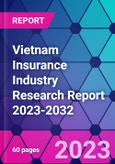In 2021, there are 76 service providers in Vietnam's insurance market, including 33 single-member limited liability companies and 11 limited liability companies with more than one person. In addition, the operation of 18 representative offices of foreign insurance companies in Vietnam's market has played a positive role in improving the investment environment and increasing the confidence of foreign investors in conducting insurance business operations in Vietnam.
In 2021, the insurance sector has been growing steadily with the growth rate of GDP compared to GDP. The industry's revenue (including investment income) reached VND255,876 million (about $11 million), of which, insurance premiums amounted to VND218,357 million (about $9,389,000), and investment income amounted to VND37,519 million (about $1,613,300). In 2021, total underwritten premiums for life insurance in Vietnam amounted to VND59,135 billion (about US$2,543 million), a year-on-year increase of 4.34%. Compared to 2020, most of the key businesses achieved high growth rates, such as aviation insurance (38.77%), agricultural insurance (32.67%), cargo insurance (21.58%), liability insurance (21.58%), fire and explosion insurance (17.66%), hull and P&I (13.26%), property insurance (6.63%), business interruption insurance (5.73%), health insurance insurance (5.73%), and health insurance (4.34% year-on-year). ), and health insurance coverage (3.77%). Meanwhile, other business remained at a low level, such as credit and financial risks (down 11.2%), motor insurance (down 6.25%), and surety insurance (down 6.05%).
Overall, Vietnam's insurance market remains highly concentrated among the "big five" non-life insurers. They are Bao Viet (15.13%), PVI Insurance (14.02%), PTI (9.87%), Bao Minh (7.60%) and Mic (6.65%). 27 other non-life insurers and branches of foreign non-life insurers in Vietnam contributed 46.72% of premium income.
According to the research, in 2022, Vietnam's insurance industry will have a total premium income of about VND246 trillion (about US$10.5 billion), an increase of about 15% from 2021. Of this, non-life insurance premium revenue is about VND67.6 trillion (about $2.88 billion) and life insurance sector revenue is about VND178.3 trillion ($7.62 billion).
As Vietnam's economy grows, so does the insurance awareness of its residents.The analyst expects Vietnam's insurance premium income to reach US$37.5 billion by 2032, growing at a compound annual growth rate (CAGR) of 13.3% from 2023 to 2032.
For investors, there are plenty of investment opportunities in Vietnam's insurance sector.
Topics covered:
- Overview of the insurance industry in Vietnam
- Economic and policy environment of the insurance industry in Vietnam
- What is the impact of COVID-19 on the insurance industry in Vietnam?
- Vietnam Insurance Industry Market Size, 2023-2032
- Analysis of major Vietnamese insurance industry producers
- Key Drivers and Market Opportunities in Vietnam's Insurance Industry
- What are the key drivers, challenges and opportunities for the insurance industry in Vietnam during the forecast period 2023-2032?
- Which are the key players in the Vietnam insurance industry market and what are their competitive advantages?
- What is the expected revenue of Vietnam insurance industry market during the forecast period of 2023-2032?
- What strategies have been adopted by the key players in the market to increase their market share in the industry?
- Which segment of the Vietnam insurance industry market is expected to dominate the market by 2032?
- What are the main unfavorable factors facing the insurance industry in Vietnam?
Table of Contents
Companies Mentioned
- Bao Viet Insurance Corporation (Bao Viet)
- Bao Minh Insurance Corporation (Bao Minh)
- Petrolimex Insurance Corporation (Pjico)
- Prudential Vietnam Assurance Private Limited (Prudential)
- AIA (Vietnam) Life Insurance Company Limited (AIA)
- Manulife (Viet tnam) Limited (Manulife)
- PVI Insurance Corporation (PVI)
- Post - Telecommunication Join Stock Insurance Corporation (PTI)
- Dai-ichi Life Insurance Company of Vietnam Ltd. (Dai-ichi Life)
- Military Insurance Corporation (MIC)
Methodology
Background research defines the range of products and industries, which proposes the key points of the research. Proper classification will help clients understand the industry and products in the report.
Secondhand material research is a necessary way to push the project into fast progress. The analyst always chooses the data source carefully. Most secondhand data they quote is sourced from an authority in a specific industry or public data source from governments, industrial associations, etc. For some new or niche fields, they also "double-check" data sources and logics before they show them to clients.
Primary research is the key to solve questions, which largely influence the research outputs. The analyst may use methods like mathematics, logical reasoning, scenario thinking, to confirm key data and make the data credible.
The data model is an important analysis method. Calculating through data models with different factors weights can guarantee the outputs objective.
The analyst optimizes the following methods and steps in executing research projects and also forms many special information gathering and processing methods.
1. Analyze the life cycle of the industry to understand the development phase and space.
2. Grasp the key indexes evaluating the market to position clients in the market and formulate development plans
3. Economic, political, social and cultural factors
4. Competitors like a mirror that reflects the overall market and also market differences.
5. Inside and outside the industry, upstream and downstream of the industry chain, show inner competitions
6. Proper estimation of the future is good guidance for strategic planning.

LOADING...
Table Information
| Report Attribute | Details |
|---|---|
| No. of Pages | 60 |
| Published | August 2023 |
| Forecast Period | 2023 - 2032 |
| Estimated Market Value ( USD | $ 12.18 Billion |
| Forecasted Market Value ( USD | $ 37.5 Billion |
| Compound Annual Growth Rate | 13.3% |
| Regions Covered | Vietnam |
| No. of Companies Mentioned | 10 |









